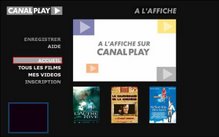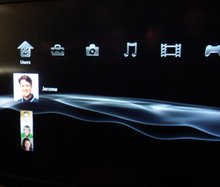There are plenty of sources of torrent-delivered video available, but how can a person with little or no engineering skills get these videos delivered directly to their living room TV? Well, it is now possible to do so with a new configurable TV-website that is viewable on any Active-TV-enabled networked TVs, such as those TVs connected to a D-link DSM-520.
For those among you who have the right to download video torrent files (i.e. peer-to-peer sharing, P2P), and find it convenient to view and select available torrents from the TV rather than the PC, the new TV-website makes it possible to select and start a torrent, monitor its progress, and finally watch the downloaded video – all from the TV. Hence, there is no need for a PC keyboard to browse and select a particular torrent, let alone attach a PC to the TV.
As discussed in a
previous blog article, when accessing P2P video, the system relies on a networked-PC using
uTorrent to assist the TV with torrenting. In other words, the TV UI remotely drives the PC’s uTorrent engine.
Available videos are listed at the TV according to an XML configuration file, 'torrentSites.xml'. A user must build their own torrentSites.xml file which is stored on their PC. An example is provided to help with understanding the layout and syntax.
Possibly following a broadcaster trend, Norwegian Broadcaster (NRK) makes
programmes available for free via torrent distribution. US channel Democracy Now! also distributes
programmes via torrent. Canada’s public broadcaster
CBC distributes the “Canada's Next Great Prime Minister” shown. Partnering with CBC, the bittorrent aggregation site Mininova supplies a DRM-free copy of the video torrent file. The required torrentSites.xml entry for the NRK and DN! video is below:
<?xml version="1.0" encoding="utf-8" ?>
<rss>
<channel>
<item>
<title>Norwegian (NRK)</title>
<description>Norwegian Broadcasting (NRK) Nordkalotten 365, defined in my PC file torrentSites.xml</description> <link>http://nrkbeta.no/torrent/monsen/nordkalotten365.rss</link> <image>http://www.nrkbeta.no/torrent/monsen/nrklogo.png</image>
</item>
<item>
<title>Democracy Now!</title>
<description>Democracy Now!, defined in my PC file torrentSites.xml</description>
<link>http://ewheel.democracynow.org/rss.xml</link>
<image>http://images.democracynow.org/dn-logo-for-podcast.png</image>
</item>
</channel>
</rss> The two entries or items in the above torrentSites.xml file, appear in the TV menu as shown in the screen-shots below. They are shown on the left-side menu.

Torrent si
tes make their torrents available via lists which are distributed via RSS. These lists generally conform to a similar format. This similarity enables torrenting tools such as uTorrent to generally access RSS data. Similarly, the TV-website has managed to “read” the RSS address provided by the XML <link> element and so lists the available torrents on the right-side menu.

Some torrent distribution sites support searching for a particular torrent. This requires search-words to be passed to the torrent site. To support searching, an XML entry such as the example below must be used.
<link search="MATCH" >http://www.site_address/MATCH/more_address</link>The use of "search=" in the <link> entry indicates that a pop-up keyboard will be used when the menu entry is selected. This enables search-words, such as "election news" to be entered on the TV screen. The keywords replace the XML token “MATCH” in the formation of an RSS url which will list, in our case, only torrents containing the name “election news”.
Before the TV can “talk” to the uTorrent engine running on the PC, it is important that they both be configured correctly; set-up the PC first. As previously
described, uTorrent “Preferences” must be set to support an “incoming connection”.

Conveniently for us, the uTorrent Web UI interface enables remote login to the torrent PC. The remote login ID must be set to “active-TV” with password “pass”. This is the initial password used by the TV-website, but it can be changed to your own preference; however, make sure the ID on the uTorrent TV-web is set to the same password. Use the TV menu entry “Change uTorrent Pass” to accomplish this – change the PC-side password first.

Before using the “My Active uTorrents” TV menu entry, make sure the PC and TV-side uTorrent passwords are set correctly. The “My Active uTorrents” enables reviewing the progress of currently active torrents. When download reaches 100%, the video can be viewed on the TV by simply using the TV’s IR remote to click on the torrents menu entry.

For convenience, the TV UI reports if a video has already been viewed after prior download completion. This helps keep a track of what you have been watching,

The uTorrent TV-website is very flexible given the ability for a user to define their own torrentSites.xml. Note that it is entirely the responsibility of the user to ensure that they have the legal right to access any video or content made available by the torrentSites.xml file they make use of. For more information about a users’ copyright responsibilities and DSM-520 operaton, please see the D-link
support site. A beta version of the above TV-website is available for download and testing from this blogsite (see Free TV-web Channels). (Also see newer blog entry "
Adding Live TV streams to my living room TV".)
Daniel Mann
































